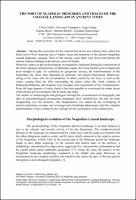Chapter The port of Neapolis: memories and traces of the coastal landscape in ancient times
| dc.contributor.author | Cirillo, Clelia | |
| dc.contributor.author | Acampora, Giovanna | |
| dc.contributor.author | Scarpa, Luigi | |
| dc.contributor.author | Russo, Marina | |
| dc.contributor.author | Bertoli, Barbara | |
| dc.contributor.author | Marcolongo, Loredana | |
| dc.date.accessioned | 2023-05-01T13:45:56Z | |
| dc.date.available | 2023-05-01T13:45:56Z | |
| dc.date.issued | 2022 | |
| dc.identifier | ONIX_20230501_9791221500301_249 | |
| dc.identifier.uri | https://library.oapen.org/handle/20.500.12657/62833 | |
| dc.description.abstract | During the excavation for the construction of two new subway lines, which run from East to West along the city of Naples, traces and memories of the Greek-Roman port of Naples and the ancient Neapolitan coastal landscape emerged. The studies of the reconstruction of geoarchaeological prospecting campaigns clarified how the bay has been disappearing over the centuries. This phenomenon was caused by the overlapping of natural (subsidence, swamps, and coverings) and of anthropic phenomena, until the complete transformation of the coastline by the castings for the construction of the modern port. | |
| dc.language | English | |
| dc.relation.ispartofseries | Monitoring of Mediterranean Coastal Areas: Problems and Measurement Techniques | |
| dc.subject.classification | thema EDItEUR::R Earth Sciences, Geography, Environment, Planning::RN The environment | en_US |
| dc.subject.other | The port of Neapolis | |
| dc.subject.other | Costal Landscape | |
| dc.subject.other | Archeological Discover | |
| dc.subject.other | Morphological evolution | |
| dc.title | Chapter The port of Neapolis: memories and traces of the coastal landscape in ancient times | |
| dc.type | chapter | |
| oapen.identifier.doi | 10.36253/979-12-215-0030-1.78 | |
| oapen.relation.isPublishedBy | bf65d21a-78e5-4ba2-983a-dbfa90962870 | |
| oapen.relation.isbn | 9791221500301 | |
| oapen.series.number | 1 | |
| oapen.pages | 12 | |
| oapen.place.publication | Florence |

